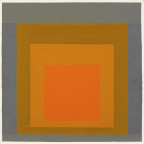Biography
Josef Albers made the first of his Homage to the Square paintings in 1950 when he was sixty-two years old. Over the next 25 years the format of three or four quasi-concentric squares painted in precisely modulated colours placed against each other was the subject of oil paintings on masonite (hardboard), lithographs, screen prints, tapestries and large interior walls.
This exhibition focuses on the smaller Homages measuring between 24 x 24 inches and 16 x 16 inches (the largest of the Homage to the Square paintings measures little more than 48 x 48 inches square). Whatever the size of Albers’ paintings, they are always intimately related to the human scale. He also saw colour in the context of human relationships, as the vehicle of a strong moral order. ‘Colour,’ he wrote, ‘behaves like man in two distinct ways: first in self-realisation and then in the realisation of relationships with others.’ ‘In other words,’ as he went on to say, ‘one must combine both being an individual and being a member of society. The authority of even the smallest of these works grows out of his conviction that ethics and aesthetics are indivisible.’
As Michael Craig-Martin points out in his catalogue essay, Albers believed that colour was in essence a matter of perception, and he goes on to say, Albers created the format of the Homage to the Square paintings so as to be able to explore and exploit the instability of colour principally in regard to quantity and environment. Each painting creates a world from just three or four colours, but these colours confront each other in different amounts to different effect across the surface of the painting, producing subtle but complex shifts of hue, tone, transparency, and opacity.







